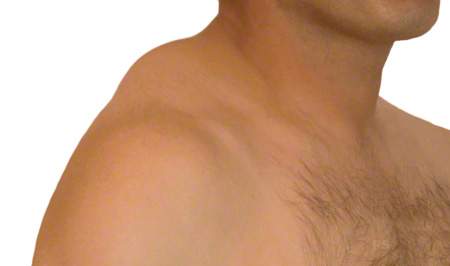If the lipoma occurs in large numbers and in the sense of an increase in fatty tissue in certain areas of the body, it is a lipomatosis.
A lipoma, a fatty tumor, is benign and grows slowly. It is usually well encapsulated and is most commonly found in the subcutaneous fatty tissue (abdomen, back, arms, legs, neck, head). However, lipomas also occur in the muscles, chest (in the mediastinum) and abdominal cavity. Organs can also be affected. In principle, it can develop anywhere where there is fatty tissue. If several lipomas are present, this is referred to as lipomatosis.
The lipoma has many faces under the microscope. They will not be discussed in detail here. However, some types should be mentioned briefly: Angiolipoma, pleomorphic lipoma, myxolipoma, spindle cell lipoma, fibrolipoma, myolipoma, etc.
Lipoma must be distinguished from lipoedema, in which the increase in fat is not demarcated, but is nevertheless usually limited to the typical areas of the legs and upper arms.
When should a lipoma be removed? Whenever it causes discomfort and shows a strong tendency to grow. Even if there is the slightest doubt that the lipoma is benign, it should be operated on. A lipoma can only be diagnosed as such with 100% certainty if it is sent to a pathologist after removal and examined under a microscope.
Our surgeons Dr. Schumann and Dr. Schumann-Averkiou are available to answer your questions.
Contents
Lipoma treatment
There is no effective conservative lipoma therapy that is scientifically sound.
The lipoma must be removed with a knife under local anaesthetic or, depending on the location and size, under general anaesthetic. In the case of larger lipomas, the excess skin is often removed in a spindle shape. In many cases, the surgeon will see a deep vascular pedicle, which must be carefully ligated to prevent secondary bleeding. After the operation, a defect often remains in the fatty tissue at the site where the lipoma was located. This can also be observed in the case of a larger pouch. This defect should be corrected if possible. This can be done by preparing a fat flap that is pushed into the defect. Unfortunately, this is not always successful, so that a dent may remain visible after the operation.

Frequently asked questions about lipoedema treatment
How can you recognize a lipoma?
The lipoma grows slowly. On palpation, it can be soft or very hard. The size ranges from barely palpable pea-sized to the size of a handball. Fat tumors are usually easy to move and have a soft consistency. However, they can sometimes be very rough. If the fatty tumor cannot be moved, other tumors must be excluded – especially malignant changes! One such tumor may be the rare liposarcoma, which also develops from fat cells, but which degenerate. In contrast to lipoma, liposarcoma grows quickly, is not displaceable and occurs at an advanced age.
The extent of a fatty tumor can usually be well defined by ultrasound. In special cases, an MRI (magnetic resonance imaging) is necessary.
Which complaints are typical?
Normally, the lipoma in the subcutaneous fatty tissue does not cause any discomfort, so it is removed for cosmetic reasons. It is perceived as unaesthetic above a certain size. However, very large lipomas can also cause mechanical damage due to rubbing. In some cases, lipomas can cause pain, especially if they press on nerves. Sensory disturbances can also occur in the area of the skin.
Can lipoma be treated with liposuction?
Liposuction can be used to remove large fatty tumors in particular. The incisions required for the cannulas are small. The affected areas can be treated in such a way that there are usually no dents to worry about. The disadvantage, however, is that the lipoma cannot always be completely suctioned out. The remaining fat cells can grow again and again lead to a fat tumor. The lipoma cells are also much more difficult for the pathologist to assess, as they have been subjected to severe mechanical trauma and are largely destroyed. The connective tissue, usually smaller lipomas are sometimes very hard and therefore not accessible to liposuction.
What should I bear in mind after the operation?
In the case of a small lipoma, there are no special requirements for follow-up treatment.
After surgery on a large fatty tumour with a strong vascular pedicle, the risk of post-operative bleeding can be minimized with a good pressure bandage. A certain degree of immobilization is also helpful here. Compression garments should sometimes be used for large wound cavities. This also applies after liposuction of a lipoma.
Related topics around this theme
- Liposuction
- Lipomatosis, which also includes lipedema, is a disease associated with a fat distribution disorder in which multiple (many) lipomas or a lipoma-like accumulation of fatty tissue is found in certain regions.
- Lipedema


